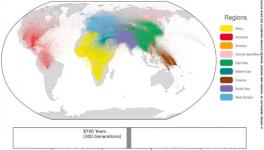Humans May Have Evolved in Africa From Intermingling Population, New Study Suggests
Image Courtesy: Wikimedia Commons
It is widely accepted that our species, the Homo sapiens originated from Africa. However, there remains differences in theories and predictions on how humans actually evolved. The most widely held idea about human origin is that it originated from a single region and a single ancestor in Africa. However, new ideas, contesting this have now come up. And a recent study published in Nature, using powerful computer modelling of vast genomic data bolsters this idea. The study suggests that humans emerged from a plethora of ancestral populations that existed in the continent.
The Nature study suggests that the ancient populations lived in different places in Africa and migrated from one region to other and in this process, they mingled with one another for thousands of years. The study model encompasses data of the genomic information from African and Eurasian population of today along with that from Neanderthal remains.
In an article written about the study findings written by Jude Coleman, evolutionary archaeologist (Max Planck Institute of Geoanthropology, Jena, Germany) Eleanor Scerri commented a: “The study contributes more evidence to the idea that there is no single birthplace in Africa, and that human evolution is a process with very deep African roots.”
Scerri, further commenting on the conventional theory of the single-origin of humans, that has remained popular for decades, said that this theory was based on fossil records, but the theory does not fit well with the data. The physical traits that uniquely attributable to Homo sapiens did emerge throughout the continent of Africa around three to one lakh years back.
The study’s authors try to portray the evolution in the form of a ’weakly structured stem’, like those in a vine. Imagine a big tree having one origin stem and the branches emanating from it. The conventional idea about the location from where humans evolved in Africa is an analogy to it. Now, imagine a tangled vine, where branches are weakly separated.
The study’s authors portray human evolution in this form, where the branches are intertwining and are separated only weakly. In ancient time, the ancestral stem consisted of populations that were localised at different places in Africa and they moved and interbred for millennia. This process led to sharing of the genetic differences they had. Scerri, commenting on it stated, “Our roots lie in a very diverse overall population made up of fragmented local populations.”
According to Brenna Henn, a corresponding author of the study and a human geneticist at University of California, Davis, even if the idea of multiple origin is not new, the explanation through the analogy of a ‘weakly structured stem’ is and the models in the study consist of parameters that were not used in previous studies on multiple origin of human evolution.
The tram of researchers developed software to incorporate the vast genomic data used in the study. The study considered genome data from present populations of East and West Africa along with the Nama people of Southern Africa. This enabled the researchers to contain genomic data from diverse African population.
It is worth mentioning here that previous works had data focused only on West African population, which led them to fall short of the genomic diversity present in Africa.
Commenting on it, Henn said, “We really wanted to sit down and very systematically evaluate the models in a more creative way.” It helped Henn’s team to track the travel of the genes over time and across generations. Moreover, the models in the study also used variables such as migration and merging of population which helped them predicting gene flow over years. The researchers then compared their predictions with that of the genetic variation present today and determined which if their models can fit the data best.
It is also important to mention here that there has been another way of looking at the human diversity of today. This idea states that Homo sapiens interbred with other archaic human species (Neanderthal) and eventually got isolated. However, the new study by Henn’s team suggests that the weakly structured stem model fits with the data better and hence provides clearer picture of the human genetic diversity present today.
Get the latest reports & analysis with people's perspective on Protests, movements & deep analytical videos, discussions of the current affairs in your Telegram app. Subscribe to NewsClick's Telegram channel & get Real-Time updates on stories, as they get published on our website.
























